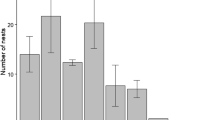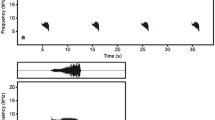Abstract
Sexual selection is generally assumed to be weaker in monogamous than in polygynous animals. Recently, though, extra-pair fertilizations have been hailed as an important force in generating variance in reproductive success among males in socially monogamous species, thereby increasing the intensity of sexual selection. To see if extra-pair copulations contribute to variance in male reproductive success in the house finch (Carpodacus mexicanus), we used DNA fingerprinting to determine the paternity of chicks from 35 nests. This species is a socially monogamous passerine in which plumage brightness serves as a sexually selected indicator of male quality. Out of 119, nestlings 10 (8.3%) were fathered by a male other than the attending male, but cuckoldry occurred randomly with respect to the plumage colouration, size, or age of the attending male. Thus extra-pair fertilizations do not generate variance in male reproductive success with respect to plumage colour. On the other hand, a strongly male-biased sex ratio and asynchronous breeding by females may generate substantial variance in male reproductive success and could explain the evolution of ornamental colouration.
Similar content being viewed by others
References
Andersson M (1986) Evolution of condition-dependent sex ornaments and mating preferences: sexual selection based on viability differences. Evolution 40:804–820
Arnold SJ (1983) Sexual selection: the interface of theory and empiricism. In: Bateson P (ed) Mate choice. Cambridge University Press, Cambridge, pp 67–107
Birkhead TR, Møller AP (1992) Sperm competition in birds: evolutionary causes and consequences. Academic Press, London
Brown CR, Stutchbury BJ, Walsh PD (1990) Choice of colony size in birds. Trends Ecol Evol 5:398–403
Brush AH, Power DM (1976) House finch pigmentation: carotenoid metabolism and the effect of diet. Auk 93:725–739
Burke T, Bruford M (1987) DNA fingerprinting in birds. Nature 327:149–152
Burley N (1991) Mate selection by multiple criteria in a monogamous species. Am Nat 117:515–528
Darwin C (1871) The descent of man, and selection in relation to sex. John Murray, London
Dominey WJ (1983) Sexual selection, additive genetic variance and the ‘phenotypic handicap’. J Theor Biol 101:495–502
Fisher RA (1930) The genetical theory of natural selection. Clarendon Press, Oxford
Galbraith DA, Boag PT, Gibbs HL, White BN (1991) Sizing bands on autoradiograms: a study of precision for scoring DNA fingerprints. Electrophoresis 12:210–220
Georges M, Lequarré A-S, Castelli M, Hanset R, Vassart G (1988) DNA fingerprinting in domestic animals using four different minisatellite probes. Cytogen Cell Gen 47:127–131
Grafen A (1990) Sexual selection unhandicapped by the Fisher process. J Theor Biol 144:473–516
Hamilton TR (1991) Seasonal movement of house finches in the midwest. N Am Bird-Bander 16:119–122
Hamilton WD, Zuk M (1982) Heritable true fitness and bright birds: a role for parasites? Science 218:384–387
Hill GE (1990) Female house finches prefer colorful males: sexual selection for a condition-dependent trait. Anim Behav 40:563–572
Hill GE (1991) Plumage coloration is a sexually selected indicator of male quality. Nature 350:337–339
Hill GE (1992) The proximate basis of variation in carotenoid pigmentation in male house finches. Auk 109:1–12
Hill GE (1993a) Geographic variation in carotenoid plumage pigmentation of house finches. Biol J Linn Soc 49:63–86
Hill GE (1993b) House finch. In: Poole A, Gill F (ed) Birds of North America, no. 46. American Ornithologists' Union, Philadelphia
Hill GE (1993c) The proximate basis of inter- and intea-population variation in female plumage coloration in the House Finch. Can J Zool 71:619–627
Hill GE (1994) Geographic variation in male ornamentation and female mate preference in the house finch: a comparative test of models of sexual selection. Behav Ecol 5:20–30
Hoelzer G (1989) The good parent process of sexual selection. Anim Behav 38:1067–1078
Hoysak DJ, Weatherhead PJ (1991) Sampling blood from birds: a technique and an assessment of its effect. Condor 93:746–752
Jeffreys AJ, Wilson V, Thein SL (1985) Hypervariable “minisatellite” regions in human DNA. Nature 314:67–73
Kempenaers B, Verheyen GR, Van den Broeck M, Burke T, Van Broeckhoven C, Dhondt AA (1992) Extra-pair paternity results from female preference for high quality males in the blue tit. Nature 357:494–496
Kirkpatrick M, Price T, Arnold SJ (1990) The Darwin-Fisher theory of sexual selection in monogamous birds. Evolution 44:180–193
Kodric-Brown A, Brown JH (1984) Truth in advertising: the kinds of traits favored by sexual selection. Am Nat 124:309–323
Kornerup A, Wanscher JH (1983) Methuen handbook of colours. Methuen, London
Michener H, Michener JR (1931) Variation in color of male house finches. Condor 33:12–19
Møller AP (1988) Female choice selects for male sexual trait ornaments in the monogamous swallow. Nature 322:640–642
Nur N, Hasson O (1984) Phenotypic plasticity and the handicap principle. J Theor Biol 110:275–297
Oring LW, Fleischer RC, Reed JM, Marsden KE (1992) Cuckoldry through stored sperm in the sequentially polyandrous spotted sandpiper. Nature 359:631–633
Payne R (1984) Sexual selection, lek and arena behavior, and sexual size dimorphism in birds. Ornithol Monogr 33:1–53
Seutin G, White BN, Boag PT (1991) Preservation of avian blood and tissue samples for DNA analyses. Can J Zool 69:82–90
Smith HG, Montgomerie R, Põldmaa T, White BN, Boag PT (1991) DNA fingerprinting reveals relation between tail ornaments and cuckoldry in barn swallows,Hirundo rustica. Behav Ecol 2:90–98
Sokal RR, Rohlf FJ (1981) Biometry, 2nd edn. Freeman, San Francisco
Thompson WL (1960) Agonistic behavior of the house finch. I. Annual cycle and display patterns. Condor 62:245–271
Trivers RL (1972) Parental investment and sexual selection. In: Campbell B (ed) Sexual selection and the descent of man. Heinemann, London, pp 136–179
Westneat DF (1987) Extra-pair fertilizations in a predominantly monogamous bird. Anim Behav 35:877–886
Westneat DF (1993) Polygyny and extra-pair fertilizations in eastern red-winged blackbirds. Behav Ecol 4:49–60
Westneat DF, Noon WA, Reeve HK, Aquadro CF (1989) Improved hybridization conditions for DNA “fingerprints” probed with M13. Nucleic Acids Res 16:4161
Wetton JH, Carter RE, Parkin DT, Walters D (1987) Demographic study of a wild house sparrow population by DNA fingerprinting. Nature 327:147–149
Zahavi A (1977) The cost of honesty (further remarks on the handicap principle). J Theor Biol 67:603–605
Author information
Authors and Affiliations
Rights and permissions
About this article
Cite this article
Hill, G.E., Montgomerie, R., Roeder, C. et al. Sexual selection and cuckoldry in a monogamous songbird: implications for sexual selection theory. Behav Ecol Sociobiol 35, 193–199 (1994). https://doi.org/10.1007/BF00167959
Received:
Accepted:
Issue Date:
DOI: https://doi.org/10.1007/BF00167959




